Rady Ananda
Activist Post
Though many survivalists like to prepare for TEOTWAWKI (the end of the world as we know it), joblessness and homelessness have led me to the end of the world as I know it. With coffee in hand, I opened the warehouse door of my temporary digs to greet the dawn. Only, it’s noon, there’s a downpour, and the smell of rubber from a pile of decomposing tires greets me. This marks Month 4 in New Orleans and two years since I was laid off.
In this vein, I finally started reading Mat Stein’s two survival books, When Technology Fails (2008) and When Disaster Strikes (2011). I also headed over to Jim Rawles’ Survival Blog and Mat’s website, whentechfails.com.
Instead of a lone-wolf, Mad Max world which plays well on film, Stein reasonably argues that individual survival relies on a community of like-minded folks. So plan your survival migration or shelter with room for your core group. The essential wisdom from both books and most survival websites is to plan a strategically sound survival budget, taking into account the climate of where you expect to be after you hit the road.
Few experts would call the US a failed or fragile state given to eco-migration, but most Americans already live in toxic zones, with our land, air and water being systematically poisoned by industry. New Orleans is only one of many areas suffering from hyper-industrialization and weather destruction. Locals call the corridor from here to Baton Rouge, “Cancer Alley.”
Thanks to Corexit and the Macondo Blowout (among hundreds of other oil “spills”), Gulf seafood is unfit for human consumption, and anglers and beachcombers are suffering from a host of health issues including respiratory failure. Birds, turtles, dolphins, and other sea life are dying in mass numbers or are showing up deformed, while federal agencies insist all is well.
I met a man who helped with the cleanup. The toxic brew severely damaged circulation in both his legs, leaving him wheelchair-bound. Grandmothers of the Gulf organizer, Laura Regan, insists her and her husband’s respiratory problems are from swimming in the Gulf after authorities promised the water was safe. She, along with most coastal residents, believe they are still spraying Corexit today. That may explain why the Louisiana Senate buried SB 97 in committee last year, which would have banned Corexit and any other oil dispersant not categorized as “Practically Non-Toxic.”
My romantic notion of sticking my toes in the famous Mississippi after I got here was sullied by the strong industrial odor wafting from the river. It sickened both of us who walked the levy that day.
All over the planet, giant multinational corporations are singly and jointly destroying the landbase for huge swaths of people, and New Orleans is no exception. Three major wars settled this area so that tens of thousands of oil wells could be built, right along with all the chemical and oil refineries, labs, agrochemical dumps, and the 25-year-old Waterford nuclear plant, 20 miles outside the city.
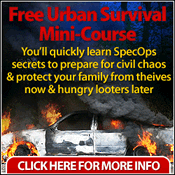 Because Fukushima radiated the Northern Hemisphere; because fracking releases rock-bound uranium that contaminates our local water table; and because I’m in Cancer Alley just miles from Waterford, this first essay focuses on nuclear survival.
Because Fukushima radiated the Northern Hemisphere; because fracking releases rock-bound uranium that contaminates our local water table; and because I’m in Cancer Alley just miles from Waterford, this first essay focuses on nuclear survival.
Some nuclear survival tips are obvious. Dr John W. Gofman, a distinguished medical and nuclear scientist who worked on the Manhattan Project to develop the atomic bomb estimated in 2001 that 75% of US women who develop breast cancer get it from medical radiation. Simply refuse such tests, including airport body scanners.
When the US Supreme Court thwarted public will and handed Bush Florida, and thereby the presidency, we were led into 9/11 and nuclear war on the Middle East and Africa. Bob Koehler writes:
Iraq Syndrome must include awareness of our toxic legacy, in particular the radioactive fallout resulting from exploding several thousand tons of depleted uranium munitions. Last year, the International Journal of Environmental Research and Public Health published a study of the devastated city of Fallujah, pointing out that, among much else, it is experiencing higher rates of cancer, leukemia and infant mortality than Hiroshima and Nagasaki did in 1945. And birth defects abound: ‘Young women in Fallujah are terrified of having children,’ a group of British and Iraqi doctors reported.
Industrial civilization’s war on the environment is no less radioactive. The US hosts 25% of the world’s nuclear power plants, and even without incidents or accidents, they leak radiation into the local environment, as evidenced by the cancer clusters around nuke plants. Being in New Orleans, I’m exposed daily to whatever is dumped in the Mississippi, including leaking radioactive particles from the several nuke plants that dot its length.
Lest anyone believe health officials and nuclear energy proponents that the harm from Fukushima is minimal (and no longer poses a threat), all they need do is look at the Chernobyl casualties, where only one reactor was involved. Last year, researchers published their review of over 5,000 scientific articles and studies and concluded that a million people have succumbed to Chernobyl radiation. According to one source, the authors explain:
Emissions from this one reactor exceeded a hundred-fold the radioactive contamination of the bombs dropped on Hiroshima and Nagasaki. No citizen of any country can be assured that he or she can be protected from radioactive contamination. One nuclear reactor can pollute half the globe. Chernobyl fallout covers the entire Northern Hemisphere.
Fukushima lost four reactors, with three in complete meltdown, but pro-nuke officials from the World Health Organization on down promise through lying teeth that this poses little to no threat to our health or the environment. As Chernobyl showed, in 30 years, we can expect many Northern Hemisphere survivors to sport tumors and other cancers resulting from radiation-damaged DNA. We can only pray for the unborn, from those healthy enough to reproduce.
Expectedly, US officials also lied about the Three Mile Island nuclear disaster, while cancer rates jumped for those nearby. Richard Wilcox wrote an excellent article on all this that is well worth the read:
Independent testing in Japan has revealed that fallout from the accident and ongoing accumulation has contaminated food supplies in the Northeast and Tokyo.
From plutonium-laden fish, “the most toxic substance known in the universe,” to radioactive cesium in California tuna, Wilcox itemizes the destruction of our food supply. Radioactive fallout, of course, contaminates grazelands, meaning our milk and dairy products absorbed it, too.
All of us have cause, right now, to ensure our water and food is clean and radiation-free. All of us have sound reason to become survivalists.
Food and Water
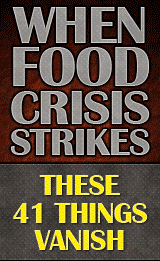 Disaster migrants and the homeless can both learn from prepper wisdom, since many of the same principles apply. Urban migration survival requires mental clarity and agility; you gotta think on your feet most of the time, despite being emotionally and physically exhausted, and perhaps even injured. You can expect the government to completely fail at providing social services, as we saw with Katrina, where authorities blocked food, water and boat rescue.
Disaster migrants and the homeless can both learn from prepper wisdom, since many of the same principles apply. Urban migration survival requires mental clarity and agility; you gotta think on your feet most of the time, despite being emotionally and physically exhausted, and perhaps even injured. You can expect the government to completely fail at providing social services, as we saw with Katrina, where authorities blocked food, water and boat rescue.
Right now, Louisiana illegally withholds food stamps for the homeless, which by federal law must be provided within four days of applying for it. Instead, I was told by Ms. Melvisson that Louisiana won’t give me food for a minimum of 17 days from the day I applied. The website is wrong, she says, when it promises food in four days. She also told me they outsource the magnetic cards to Texas. I have to presume the state doesn’t want the work despite an 8.5% unemployment rate, which really means about 20% or more, especially in New Orleans proper with all its wandering musicians, artists and street performers.
My own urban survival manual can’t publicize some survival tricks that are quintessentially my divine right, but which may be considered illegal. Dr. John Glass, a sociology professor at Collin College outside Dallas, teaches experiential homelessness. He had this to say about urban poverty:
I toured the ‘urban slum,’ and I could see how if I had to raise my kids in this setting I would steal. I would do whatever I had to do to survive. I never had that experience before.
Food market grazing is one survival method. Watertight, bug-proof containers are a must, with a good supply of mixed nuts and dried fruits, or any healthy foods that don’t require refrigeration. I’ve become a big fan of big bags of carrots.
Another tip is to procure unfluoridated water that has been carbon filtered and run through reverse osmosis. At 30 cents a gallon from the local food co-op, I drink much less of this than I should, but at least I’m getting some good water. My 3-gallon storage bottle is BPA-free, but not my 16-oz bottles. Maybe someone will donate so I can rectify that (though I’d prefer a job).
Preppers urge you to procure 5-gallon and larger water containers, but at 8 pounds a gallon, many women can’t physically haul that much water a long distance. And, if you’re on the move, haul weight is a survival factor that must be considered.
Stein covers surviving a nuclear disaster in both books, but dedicates an entire chapter in When Disaster Strikes. The last section of the book dedicates a chapter to each of several specific disasters like tornadoes, hurricanes, earthquakes, blizzards, and electromagnetic pulses. (In my next essay, I’d like to focus on EMPs, natural or otherwise.)
Radiation isn’t released into the environment only via nukes. In an earlier piece, I reported that geologist Tracy Bank found that fracking mobilizes rock-bound uranium, posing a further radiation risk to our groundwater. Because of some 65 hazardous chemicals used in fracking operations, former industry insider, James Northrup, calls it a “dirty bomb.” With 30 years of experience as an independent oil and gas producer, he explains:
The volume of fluid in a hydrofrack can exceed three million gallons, or almost 24 million pounds of fluid, about the same weight as 7,500 automobiles. The fracking fluid contains chemicals that would be illegal to use in warfare under the rules of the Geneva Convention. This all adds up to a massive explosion of a ‘dirty bomb’ underground.
What’s underground seeps into our groundwater. Disaster Strikes offers step-by-step instructions on filtering your water with soil, gravel, bucket and burlap, among many other specific instructions and suggestions.
The book also provides drawings for foragers – not only for edible plants, but medicinal ones, too, and recommends specific foraging books for your survival library.
Hank Shaw, author of Hunt, Gather, Cook, agrees with Stein in recommending Samuel Thayer for his color photographs of plants. Thayer has written two foraging books: Nature’s Garden and The Forager’s Harvest. Shaw’s top 3 (out of 11) recommendations all come from Euell Gibbons:
- Stalking the Wild Asparagus
- Stalking the Blue-Eyed Scallop
- Stalking the Healthful Herbs
Once you have access to a steady food and water supply, be sure it’s safe. Dr. Perlingieri suggests adding 2 tablespoons of raw apple cider vinegar to each gallon of water. Not only does this provide flavor, but it also aids in digestion. She also lists several immune-boosting foods, as long as they are not radioactive. See also Melissa Patterson’s Supplements Shown to Help Prevent Effects of Radiation Fall-Out, and Protocols for Nuclear Contamination – Master List.
Hawaii organic growers suggest washing your fruits and vegetables in bentonite clay, and using Boron “to capture radioactivity on our soils, gardens, orchards, etc. It also can be safely ingested by humans and animals. Boron will accept radiation and ionize it within our bodies, after which our bodies will safely [excrete] the boron and radioactivity.” (Borax is also good at killing roaches, which are ubiquitous in the urban setting.)
Hygiene
No matter the cause of your sudden homelessness, the need for good hygiene closely follows the need for clean food and water. Stein’s books list the items needed in your First Aid kit, and provide an expanded version for “long emergencies” when you may not be able to return to your home.
For urban migrant survival, friends recommend Street Smarts, though not published at a big house. I’d like to read it, and see how much of what I do is mentioned. Like hygiene — get it while you can when the facilities are clean, be extra careful when they’re not. In the summer, use fast drying shirts that you can easily wash and wear.
In a hot climate, you’ll need a sweat rag for your face, one that you wash as often as feasible, because face- and clothes-washing is now a luxury dependent on the generosity of others. You’ll also have to plan your wash for when you can hang things to dry. I use a 22″ rag that I thoroughly wet and roll up, for draping around my neck. Its length allows me to also swab my face as needed.
If injured, hygiene becomes the priority. I stepped in one of New Orleans’ foot-deep potholes and donated 5 square inches of skin to the city. I couldn’t soap it until the library opened 12 hours later. The trick to no infection was the warm soapy scrub three times a day, though I also scored some prescription skin salve. The skin has already regenerated, while the bruised ankle is still healing.
Prudence requires everyone to ‘know the exits’ and have the knowledge and tools to get there. Preppers, at the minimum, are prudent. Once a month, urges Mat Stein, you and your family should read, study and discuss a single chapter on survival preparedness. It’s also prudent not to jump in with your wallet wide open. Simple, inexpensive purchases can be made now, but long-term economical purchasing takes planning.
I’d do a hell of a lot better if I had raw milk, but Louisiana criminalized it, blocking me from its probiotic benefits. Big Pharma and Big Dairy sure get their share, simply by criminalizing the competition.
Road Income
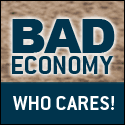 Citing an uptick in survival sales, Activist Post opened 2012 with its recommended articles on the topic. One suggests becoming economically independent of the system by monetizing your blog, becoming a picker (old junk, new street corner), or growing or making your own and selling it to local co-ops and other markets. AP itself came up with simple steps to be taken this year that include building economic independence, promising that, “prosperity awaits for those who can properly analyze the landscape and seek new opportunities and alliances.”
Citing an uptick in survival sales, Activist Post opened 2012 with its recommended articles on the topic. One suggests becoming economically independent of the system by monetizing your blog, becoming a picker (old junk, new street corner), or growing or making your own and selling it to local co-ops and other markets. AP itself came up with simple steps to be taken this year that include building economic independence, promising that, “prosperity awaits for those who can properly analyze the landscape and seek new opportunities and alliances.”
Charge $10 an hour and a dollar a mile to be a taxi, if you must, and your shocks are good. The Submerged Roads project is ongoing seven years post-Katrina. It’ll never end, though, because paving over swampland that endures an annual hurricane season ensures pothole proliferation.
During recent flooding, a car drove thru 6” of water until the road collapsed, taking out his axle. One related tip is not to drive on flood-damaged roads, and another is to keep your spare car key in your wallet.
The homeless, more than any other group, employs the axiom, “reuse, recycle, restore,” and if your body odor isn’t too strong, you might even be able to resell some of the stuff.
Study, Train and Practice
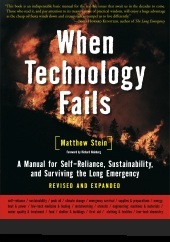 Stein hammers at conventional survival wisdom: Read, study, train and practice. What’s between your ears, he says, is more important than your gear. We need to be as proficient at providing sustenance as the tribes who’ve lived sustainably for tens of thousands of years.
Stein hammers at conventional survival wisdom: Read, study, train and practice. What’s between your ears, he says, is more important than your gear. We need to be as proficient at providing sustenance as the tribes who’ve lived sustainably for tens of thousands of years.
Fat chance you can do that in the city, but there might be some gems in wildman Steve Brill’s Identifying and Harvesting Edible and Medicinal Plants in Wild and Not So Wild Places, which Stein recommends.
A list of edible and medicinal urban plants can be found here. And here’s a recipe for pigweed, which is proliferating in the south now that the plant developed resistance to Monsanto’s RoundUp. I wanna try it.
I like how Stein organized When Disaster Strikes, in three concise sections, but prefer the older book, When Technology Fails, for a number of reasons.
For one, it’s 100 pages longer. The book is also bigger (11.5×8″ vs 9×6″). Because it’s bigger, so are the pictures. If I ever have to have actually construct my own shelter, I’ll be pulling out WTF instead of WDS.
Climate and peak oil skeptics might choke on Stein’s reasons for disaster preparation, and anyone who knows anything about HAARP or weather modification won’t find any reference to government-directed natural disasters. Regardless, Stein provides well-organized, detailed information on what a new prepper needs to know and do to survive catastrophe.
My task for August is to identify and procure edible weeds. I’d also like to try the solar water filtration gizmo, if I can find a clear plastic bottle that is BPA-free.
Rady Ananda is the creator of Food Freedom News, whose work has appeared in several online and print publications, including four books. She holds a B.S. in Natural Resources from The Ohio State University’s School of Agriculture (2003). She is LinkedIn and tweets her own work from @RadysRant; while tweeting both hers and others’ from @geobear7.
Support Rady’s work by donating to her directly – HERE.
Read other reports by Rady Ananda HERE.
You can support these survival tips by voting on Reddit HERE
linkwithin_text=’Related Articles:’

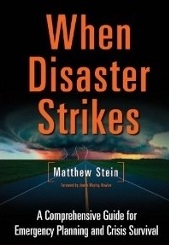

Be the first to comment on "Survival tips for the urbanite: Part 1 – Nuclear Radiation"